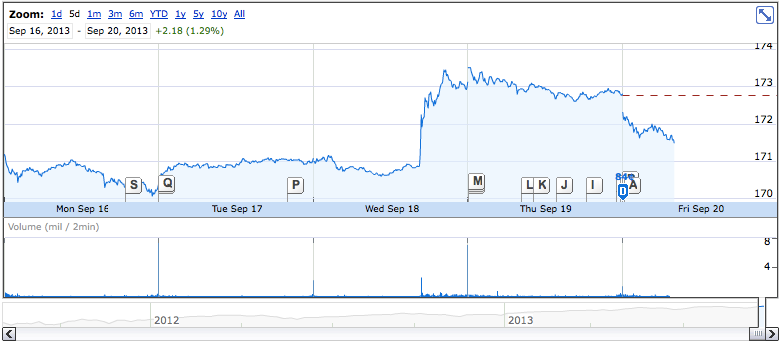 Wednesday saw a massive spike in equities, and it was easy for stockholders to be happy. But the reason for the happiness is curious: the Federal Reserve announced that it would not begin tapering its bond buyback program, known by many as QE3, in September. This means more low interest-rate loans for institutional investors, meaning more opportunities to continue leveraging to buy stocks. It also means creating an artificial limit on how high bond interest rates can go–the infamous “Bernanke put.”
Wednesday saw a massive spike in equities, and it was easy for stockholders to be happy. But the reason for the happiness is curious: the Federal Reserve announced that it would not begin tapering its bond buyback program, known by many as QE3, in September. This means more low interest-rate loans for institutional investors, meaning more opportunities to continue leveraging to buy stocks. It also means creating an artificial limit on how high bond interest rates can go–the infamous “Bernanke put.”
The popular press finds this response “unnerving”, to use a word from Mother Jones. The idea behind QE3 is that the economy is not doing well enough on its own and it needs Fed intervention. This, in turn, should tell investors that the U.S. economy isn’t doing very well and should send stocks lower.
But stocks went higher on the news. As of the time of writing, the S&P was down slightly for the day, although still above its level before the surprise announcement that tapering would not occur. So the main question is why.
There are many answers to that question, but in general the issue is that equities are trading more on macroeconomic factors than on fundamentals. In other words, an individual stock price is going up more because of expectations about the money supply and money velocity than about the fundamental value of the stock. Hence value investors like Warren Buffett are saying that it’s harder to find underpriced investments.
Trading on the Trend
In the short term, macroeconomic indicators have been impacting stocks. For someone looking to profit from this momentum, trades based on macro trends will probably work for now. This means identifying macro-oriented money managers, or developing your own portfolio strategy to capitalize on the macro trends.
In the longer term, however, bottom-up indicators are likely to take over. Whenever the QE3 program tapers to a stop, the fundamentals of company valuation will become the dominant factor in a stock’s momentum. Even now, many companies are still trading more on fundamentals than on macro trends. But, as Buffett points out, these are increasingly fewer and further between.
The problem is that no one knows how long the short term and long term will actually be, and the macro driver could last for six months or six years. It is the individual investor’s or analyst’s job to try to develop a cogent hypothesis on when these factors will be in play, and to develop an investment strategy accordingly.
Unfortunately, this means that this is a particularly difficult time in history to make money in the market. In hindsight, periods like the 1980s and 1990s were great times to be asset allocators. But the 2010s, at least so far, will probably be remembered in history as one of the toughest times for financiers.
